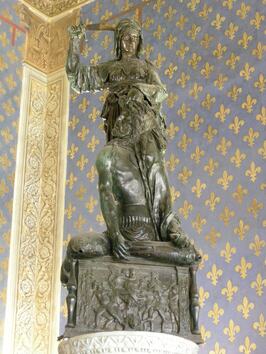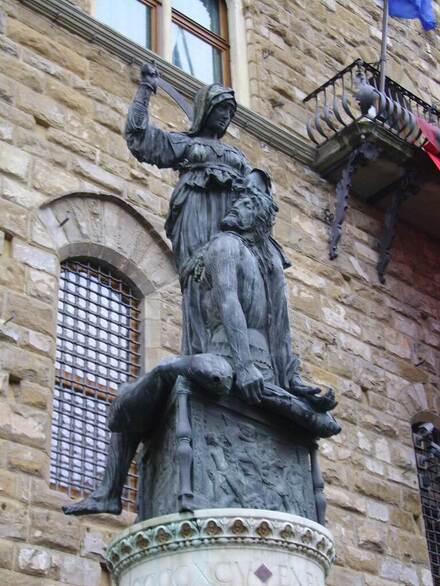|
Sailko, CC BY-SA 3.0
Where? Hall of Lilies (Sala degli Gigli) on the second floor of the Palazzo Vecchio
When? 1457-1464 Commissioned by? Cosimo de’ Medici What do you see? Judith, a beautiful Jewish widow, raises her sword to cut off the head of Holofernes, the general of the Assyrian army. She has already struck him once, which is why he looks already dead. She is holding the head of Holofernes by his hair. Judith seems to be in her thoughts, possibly still balancing the idea of killing Holofernes to protect the people from her city and violating one of the Ten Commandments (not to kill). At the same time, she is shown as a strong and fearless woman. Donatello sculpted her dress in a very realistic way. The dress looks a bit wrinkled as you may expect in this kind of scene, and it is beautifully hanging around her raised arm. The crushed body of Holofernes is laying at the feet of Judith. He looks like he is already dead, with his arms hanging unnaturally and his mouth wide open. Holofernes sits on a cushion, which bears the inscription “OPUS . DONATELLI . FLOR”, which means that this is the work of Donatello from Florence (it is the only work that Donatello signed). At the bottom of the statue, you can see some Bacchic scenes, which refer to the pride and lust of Holofernes. This bronze statue was originally gilded (painted in gold) and you can still see some of those gold remains on the sword of Judith. It is also one of the first “in the round” statues, in which you can look at the statue from all possible angles (see some pictures from different angles). A replica of this sculpture can also be found on the Piazza della Signoria in front of the Palazzo Vecchio.
Backstory: The story of Judith beheading Holofernes comes from the deuterocanonical book of Judith, chapters 10:13. Holofernes was a general in the Assyrian army and was planning to destroy the Jewish city in which Judith lived. The Jewish had no chance against the army of Holofernes and were considering to surrender. Judith was a beautiful woman and widow, and she heard about the plans of the people from her city to surrender. She decided to take matters into her own hands and goes to the camp of Holofernes’ army.
Judith convinces the Assyrians that she has reliable information on how they can conquer the whole Jewish region without casualties and she is allowed into their camp. She waits several days until Holofernes is drunk, seduces him with her beauty, and finally chops off his head when she is alone with him in his tent. She brings the head of Holofernes back to her city and devices a plan for the Jewish to kill the Assyrian army, in which they succeed. Symbolism: The sculpture shows that Judith, a simple widow, could triumph over a general from an army that was thought to be much stronger. The sculpture served as a symbol to the Florentine people to remember them that no matter how big the enemies of Florence could be, even the simplest members of society could help Florence to be triumphant. The granite base of the statue originally contained the following inscription: “Kingdoms fall through luxury [sin], cities rise through virtues. Behold the neck of pride severed by the hand of humility.” This inscription was ordered by the Cosimo de’ Medici referring to the Medici family as the defenders of the freedom of Florence. However, it was removed when the Medicis were exiled from Florence. Who is Donatello? Donatello (1386-1466) was born as Donato di Niccoló di Betto Bardi in Florence. He received his training in the workshop of a goldsmith and was also trained by Lorenzo Ghiberti. He was a sculptor who worked with various materials, including bronze, clay, stone, stucco, wax, and wood, and he created both self-standing sculptures and reliefs. After Michelangelo, many consider him to the second-best sculptor ever. Donatello’s most well-known work is the sculpture of David, which is now in the Bargello Museum. During his life, he worked and lived in Florence, Rome, Padua, and Siena.
Hall of Lilies: The walls of this room were to be decorated in 1482 by the greatest artists of that time (Biagio d’Antonia, Botticelli, Ghirlandaio, Perugino, and Piero del Pollaiolo). However, Domenico Ghirlandaio was the only one who painted a wall.
The middle of the wall depicts the deification of Saint Zenobius (the first bishop of Florence at the beginning of the 5th century). On the left and the right are characters from Roman history. The other artists backed out and instead the other walls were decorated with gold fleur-de-lys on a blue background. The fleur de lys (which means in French “lily flower”) is a stylized lily and was the symbol of the House of Plantagenet, a royal family from Anjou in France, who helped to protect the freedom of Florence. The lilies on the wall also explain the name of this room. The coffered ceiling with various ornaments and lilies and the frieze below the ceiling, which is full of lions, is created by Giuliano da Maiano. The portal connecting this room with the Audience Hall is created by the brothers Benedetto and Giuliano de Maiano. Fun fact: Little has been written about the life of Donatello, so most information about him is inferred from his work. This provides room for endless speculation as the works of Donatello were very unconventional for his time (nowadays the word unconventional has been replaced by innovative). Donatello was supposedly openly gay and had an unpleasant personality. However, he was a friend of the Medici family, which ensured him a lifelong guarantee of assignments (and he, supposedly, never rejected an assignment, however small it was). He would make whatever the Medicis asked him and therefore the Medicis could use him not only to create beautiful art but also to express the ideas of the Medici family. Interested in a copy for yourself? Framed poster (Amazon link)
Written by Eelco Kappe
References:
0 Comments
Leave a Reply. |
Categories
All
|
- Home
- Blog
-
Museums
- Alte Pinakothek
- Art Institute of Chicago
- Baltimore Museum of Art
- Barber Institute of Fine Arts
- Bargello
- Barnes Foundation
- British Museum
- Church of Sant’Anastasia
- Cleveland Museum of Art
- Courtauld Institute of Art
- Detroit Institute of Arts
- Frans Hals Museum
- Galleria Borghese
- Gallerie dell'Accademia
- Getty Museum
- Guggenheim
- Hermitage Museum
- Kunsthistorisches Museum
- Kunstmuseum Basel
- Legion of Honor Museum
- Louvre
- Mauritshuis
- Metropolitan Museum of Art
- Musee d’Orsay
- Museum of Fine Arts in Boston
- Museum of Modern Art
- National Gallery in London
- National Gallery of Art
- National Museum in Poznań
- Norton Simon Museum
- Ny Carlsberg Glyptotek
- Palace of Versailles
- Palazzo Pitti
- Palazzo Vecchio
- Petit Palais
- Philadelphia Museum of Art
- Prado
- Pushkin Museum
- Ravenna Art Museum
- Rijksmuseum
- San Diego Museum of Art
- Santa Maria delle Grazie
- St. Peter's Basilica
- Städel Museum
- Statens Museum for Kunst
- Tate Britain
- Tate Modern
- Timken Museum of Art
- Uffizi
- Vatican Museums
- Wallace Collection
-
Artists
- Altdorfer
- Anguissola
- Berlin Painter
- Bosch
- Botticelli
- Boucher
- Bronzino
- Bruegel the Elder
- Brunelleschi
- Cabanel
- Caillebotte
- Canova
- Caravaggio
- Carpeaux
- Cezanne
- Cimabue
- David
- Degas
- Delacroix
- De Maria
- Donatello
- El Greco
- Fontana
- Fra Angelico
- Fragonard
- Gauguin
- Gentileschi
- Gericault
- Gonzalez-Torres
- Goya
- Hals
- Hogarth
- Hokusai
- Ingres
- Leonardo da Vinci
- Lippi, Filippo
- Longhi, Barbara
- Lorrain
- Makovsky
- Manet
- Massys
- Matisse
- Merian
- Michelangelo
- Mochi
- Modigliani
- Monet
- Panini
- Parmigianino
- Perugino
- Picasso
- Pisanello
- Raphael
- Rembrandt
- Renoir
- Reynolds
- Rivera
- Rodin
- Rubens
- Scultori
- Seurat
- Steen
- Tintoretto
- Titian
- Toulouse-Lautrec
- Turner
- Uccello
- Van der Weyden
- Van Dyck
- Van Eyck
- Van Gogh
- Van Hemessen
- Vasari
- Velazquez
- Vermeer
- Veronese
- Vigée Le Brun
-
Locations
- Books
- About Us



